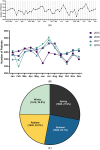Epidemiology and Viral Etiology of Pediatric Immune Thrombocytopenia through Korean Public Health Data Analysis
- PMID: 33806145
- PMCID: PMC8037772
- DOI: 10.3390/jcm10071356
Epidemiology and Viral Etiology of Pediatric Immune Thrombocytopenia through Korean Public Health Data Analysis
Abstract
Immune thrombocytopenic purpura (ITP) is prevalent in children aged 2-5 years but may occur in all pediatric age groups. In 50-60% of pediatric patients, ITP is preceded by an upper respiratory tract infection 1-4 weeks before its onset. In this study, the relationship between the development of ITP and viral infections in children was assessed. We analyzed data of 6487 patients aged < 18 years with incident ITP from the Health Insurance Review and Assessment Open Access Big Data Platform (2015 to 2018) and the Korea Disease Control and Prevention Agency. The monthly positive detection rate (PDR) of seven respiratory and four acute diarrhea viruses was calculated. The virus PDR seasonal trend data was analyzed through ARIMA modeling. The ITP diagnostic data and prevalence of viral infection 1 and 2 months prior were analyzed using the Granger test. The overall male to female (M/F) ratio was 1.2, whereas it was 1.4 in the youngest age group (< 1 year). The overall ITP incidence rate was 18.1 per 100,000 person-years. Respiratory syncytial virus, rhinovirus, rotavirus, and astrovirus infections influenced ITP occurrence in children. However, rotavirus infection is positively associated with the etiology of ITP after 1-2 months.
Keywords: children; immune thrombocytopenia; viral infection.
Conflict of interest statement
The authors declare no conflict of interest.
Figures


References
-
- Neylon A.J., Saunders P.W., Howard M.R., Proctor S.J., Taylor P.R., Northern Region Haematology Group Clinically significant newly presenting autoimmune thrombocytopenic purpura in adults: A prospective study of a population-based cohort of 245 patients. Br. J. Hematol. 2003;122:966–974. doi: 10.1046/j.1365-2141.2003.04547.x. - DOI - PubMed
LinkOut - more resources
Full Text Sources
Other Literature Sources

